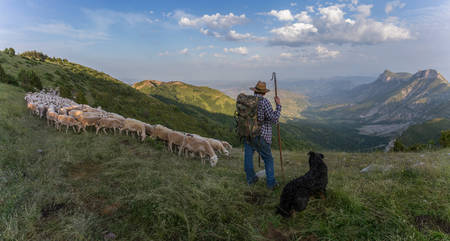
Local products from local breeds: The Geopark preserves its traditional activities and local breeds. Xisqueta is the name of a local sheep breed that helps preserving landscapes and it is used to produce wool, milk and meat. Local producers are committed to preserve traditional lamb dishes.
GEPARQUES UNESCO EN ESPAÑA
La UNESCO define y analiza los geoparques para, con esta figura, proteger los lugares y paisajes de relevancia geológica internacional que presentan un enfoque global. Estos sitios representan un interés patrimonial, geológico, turístico, de conservación y divulgación e implica a todas las comunidades locales. Cada cuatro años estos lugares son sometidos a una evaluación que presenta como objetivo mantener su condición, compaginándola con el desarrollo del geoturismo, la conservación del medio natural y la colaboración entre los miembros de red de geoparques.
Esta definición y visión nació en la década de los noventa en Europa, siendo España una de sus mayores impulsoras. En la actualidad hay más de 177 geoparques en 46 países.
El paisaje, a través de su naturaleza y estética, habla de su formación, evolución y también de sus habitantes. El patrimonio geológico es, por tanto, una gran fuente de información y recursos.
España es uno de los países que cuenta con mayor número de geoparques, espacios naturales reconocidos por la UNESCO, dando valor a su importancia patrimonial y geológica. Actualmente, existen 15 geoparques mundiales españoles:
– Parque Natural Cabo de Gata-Níjar en Almería.
– Geoparque de la Costa Vasca.
– Geoparque Mundial de Cataluña Central.
– Geoparque Orígens del Pirineo Catalán.
– Sierra de Caurel en Galicia.
– Geoparque Mundial El Hierro en las Islas Canarias.
– Geoparque de Granada.
– Geoparque Mundial de Lanzarote y Archipiélago Chinijo.
– Geoparque Las Loras en Palencia y Burgos.
– Geoparque del Maestrazgo en Teruel.
– Geoparque Molina y Alto Tajo en Guadalajara.
– Sierra Norte de Sevilla.
– Sierras Subbéticas en Córdoba.
– Geoparque Mundial Sobrarbe-Pirineos.
– Geoparque Villuercas Ibores La Jara.
__
UNESCO GEOPARKS SPAIN
UNESCO defines and analyzes geoparks in order to protect sites and landscapes of international geological significance with a global approach. These sites represent a heritage, geological, tourism, conservation and dissemination interest and involve all local communities. Every four years, these sites are subject to an evaluation that aims to maintain their status, combining it with the development of geotourism, the conservation of the natural environment and collaboration between the members of the geoparks network.
This definition and vision was born in the nineties in Europe, being Spain one of its major promoters. There are currently more than 177 geoparks in 46 countries.
The landscape, through its nature and aesthetics, speaks of its formation, evolution and also of its inhabitants. Geological heritage is, therefore, a great source of information and resources.
Spain is one of the countries with the largest number of geoparks, natural areas recognized by UNESCO, giving value to its heritage and geological importance. Currently, there are 15 Spanish Global Geoparks:
– Cabo de Gata-Níjar Natural Park in Almería.
– Basque Coast UGGp.
– Central Catalonia UGGp.
– Orígens UGGp.
– Courel Mountaings UGGp.
– El Hierro Global Geopark in the Canary Islands.
– Granada Geopark.
– Lanzarote and Chinijo Archipelago Global Geopark.
– Las Loras Geopark in Palencia and Burgos.
– Maestrazgo Geopark in Teruel.
– Molina and Alto Tajo Geopark in Guadalajara.
– Sierra Norte de Sevilla.
– Sierras Subbéticas in Córdoba.
– Sobrarbe-Pyrenees World Geopark.
– Villuercas Ibores La Jara Geopark.
__
